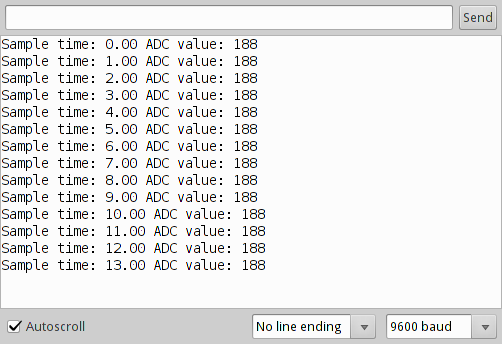Arduino Fast Serial Read
Posted : adminOn 4/13/2018Arduino data logging and speed test. (“Fast USB”).Paul says that he sees serial throughput of. But I’m using CoolTerm to read in the serial data and. May 18, 2011 Fixing Arduino’s serial latency issues. It seems like I get to a prototype faster. Once you’ve read and understood that, realize that serial. I needed a fast communication between Arduino board and my laptop while working on my first Arduino project. I was monitoring an analog input, the reading on a Hall effect sensor, and some other variables that my Arduino program was using, and that all at a high frequency, 10 kHz. That was producing.

Output waveform of Digital pin 2 using low level PORTD command. The pulse width is now 0.1250us compare to the previous of 3.8333us a big time reduction. Q: When would you use this faster IO?
A: Anywhere where you need extra faster IO like in robotic applications. Inside an ISR (interrupt service routine) where you need execute the code and exit as quick as possible so the main routine can run.
Pdf Handbook Of Thanatology 2nd Edition Free on this page. This method also uses less memory. Q: What are the dis-advantage of this faster IO method? A: There are no error checking. You can easily write to the wrong pin. It can be more difficult to debug. Really nice article and helpful too! I wrote these three Macros to make this code work for any of the 13 standard arduino pins.
Since they are Macros the code is pretty efficient and speedy. Just put these in the top of your code and you are off to the races! -Doug // Macros To Speed Up Read/Writes #define Macro_SetPin( pin, state ) ( state == LOW )? Macro_SetPinLow( (pin) ): Macro_SetPinHigh( (pin) ) #define Macro_SetPinLow( pin ) ( (pin).
Introduction Embedded electronics is all about interlinking circuits (processors or other integrated circuits) to create a symbiotic system. In order for those individual circuits to swap their information, they must share a common communication protocol. Hundreds of communication protocols have been defined to achieve this data exchange, and, in general, each can be separated into one of two categories: parallel or serial. Serial Parallel interfaces transfer multiple bits at the same time. They usually require buses of data - transmitting across eight, sixteen, or more wires. Data is transferred in huge, crashing waves of 1’s and 0’s. An 8-bit data bus, controlled by a clock, transmitting a byte every clock pulse.
9 wires are used. Serial interfaces stream their data, one single bit at a time. These interfaces can operate on as little as one wire, usually never more than four. Example of a serial interface, transmitting one bit every clock pulse. Just 2 wires required!
Think of the two interfaces as a stream of cars: a parallel interface would be the 8+ lane mega-highway, while a serial interface is more like a two-lane rural country road. Over a set amount of time, the mega-highway potentially gets more people to their destinations, but that rural two-laner serves its purpose and costs a fraction of the funds to build. Parallel communication certainly has its benefits. It’s fast, straightforward, and relatively easy to implement. But it requires many more input/output (I/O) lines.
If you’ve ever had to move a project from a basic to a, you know that the I/O lines on a microprocessor can be precious and few. So, we often opt for serial communication, sacrificing potential speed for pin real estate. Asynchronous Serial Over the years, dozens of serial protocols have been crafted to meet particular needs of embedded systems. USB (universal serial bus), and Ethernet, are a couple of the more well-known computing serial interfaces. Other very common serial interfaces include SPI, I 2C, and the serial standard we’re here to talk about today. Each of these serial interfaces can be sorted into one of two groups: synchronous or asynchronous. A synchronous serial interface always pairs its data line(s) with a clock signal, so all devices on a synchronous serial bus share a common clock.
This makes for a more straightforward, often faster serial transfer, but it also requires at least one extra wire between communicating devices. Examples of synchronous interfaces include SPI, and I 2C. Time Crisis 2nd Strike Hd Ipa Download Game. Asynchronous means that data is transferred without support from an external clock signal. This transmission method is perfect for minimizing the required wires and I/O pins, but it does mean we need to put some extra effort into reliably transferring and receiving data. The serial protocol we’ll be discussing in this tutorial is the most common form of asynchronous transfers. It is so common, in fact, that when most folks say “serial” they’re talking about this protocol (something you’ll probably notice throughout this tutorial). The clock-less serial protocol we’ll be discussing in this tutorial is widely used in embedded electronics.